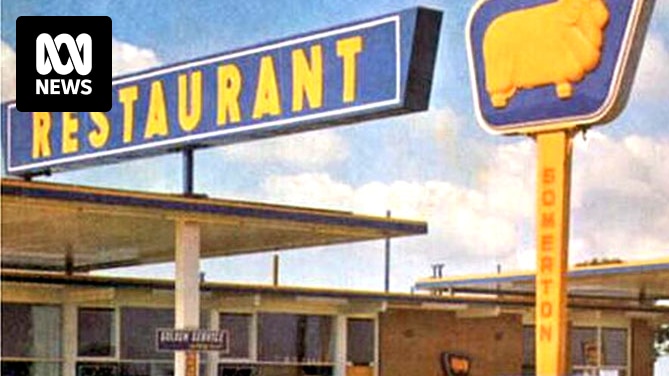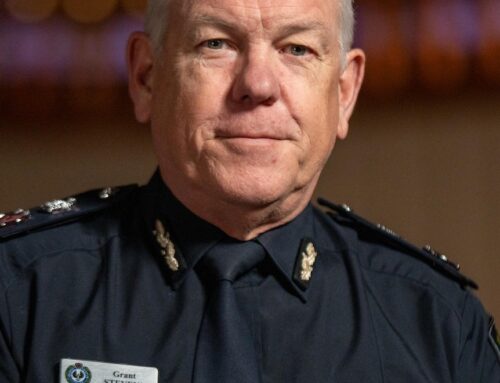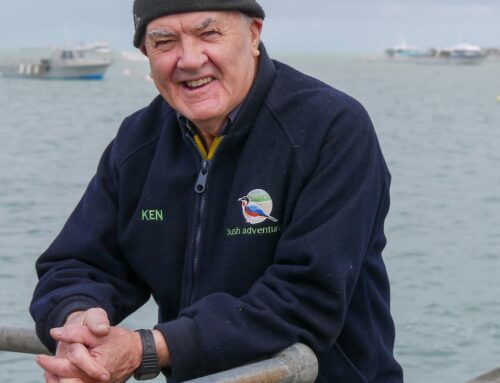There are probably a few things that come to mind when reminiscing about long road trips across Australia between the 1950s and ’70s.
Things like overheating cars, AM radio and the unmistakable icon of the Golden Fleece.
Before the days of the giant fast-food outlets, Golden Fleece restaurants were a much-looked for sign on the horizon when driving long distances.
At its peak, Golden Fleece had hundreds of roadhouses and restaurants and thousands of distributors of its fuel and chemical products.
Then in 1981 Golden Fleece all but disappeared from the landscape, almost overnight.
In the beginning
In 1913 Harold Crofton (HC) Sleigh was a shipping agent who got stuck with several tins of “motor spirit” from California that the consignee couldn’t pay for.
After selling the tins to recoup his costs, Sleigh saw how profitable the sale was due to the rising popularity of cars.
The name Golden Fleece was registered, and Australia’s first oil company was born.
Author and Australian petroleum historian Colin J. Dennett said Golden Fleece was more of an accident rather than a strategic business decision.
“Although HC Sleigh got into petrol re-selling, he was always more interested in shipping,” he said.
“At the time all his competition was large, overseas-owned oil companies so Golden Fleece became the first Australian oil company.”
The Golden Ram
Exactly why HC Sleigh chose the golden ram as his logo has been lost to history.
Some historians have said it’s linked to the Distinguished Order of the Golden Fleece, others claim that it was inspired by a golden fleece story in Greek mythology.
The golden ram image on top of hundreds of fuel pumps across Australia had a very unlikely name … David.
It was named after David of Dalkieth, who won the strong wool ram hogget prize at the 1926 Sydney Show. The ram was eventually sold for 500 guineas, which was record at the time.
“HC Sleigh developed the concept of the ram, which had a very Australiana type of appeal,” Mr Dennett said.
“Australia was known for riding on the sheep’s back thanks to the popularity of wool.”
Going it alone
In the 1920s and ’30s, petrol stations sold a variety of fuel brands. A motorist could pull up and pick from Golden Fleece, Shell or many other brands to refuel their car.
“Before the 1950s all fuel was sold through multi-brand outlets,” Mr Dennett said.
“Golden Fleece, Shell and Ampol and all the other brands had to compete for space.
“The problem was that the overseas multinationals like Shell could set the price and the others had to follow.
“Golden Fleece was one of the first to open their very own one-brand site, which the other fuel companies soon followed, becoming the norm that we see now.”
Before American takeaway
At its height, HC Sleigh Limited operated the largest restaurant chain in the country, with about 5,000 service stations, roadhouses and distributors across Australia.
“They were revolutionary in the way that they distinguished their service stations from everything else,” Mr Dennett said.
“Ampol had roadhouses but that was mainly for truck drivers.
“Golden Fleece wanted family restaurants where people could stop and sit and even get a three-course meal.
“They were the place to go before the American takeaways came along.”
Bill Whittaker, who worked at Golden fleece in Caboolture, Rockhampton and Winton from 1973 until 1981, said that in some areas, Golden Fleece was the only restaurant in town.
“They were homemade meals and I know that in smaller towns, people would go to their local Golden Fleece restaurant for dinner,” he said.
“They had restaurant managers and trained chefs and food supervisors travelling around the state checking on the quality and size portions of the food.”
Fuel crisis
Golden Fleece started to struggle during the fuel and energy crisis of the 1970s and as it didn’t own its own refinery, it was Caltex’s biggest customer.
In 1981 Peter Sleigh (HC Sleigh’s grandson) accepted an offer from Caltex to buy the company outright.
Almost immediately Golden Fleece stations were changed over to Caltex and over time the restaurants were either closed or converted to takeaway food.
“When Caltex first bought Golden Fleece, they said they were going to run two brands, but that didn’t last long and less than a year later they were phasing out the Golden Fleece brand,” Mr Whittaker said.
“Golden Fleece had a special place in people’s hearts and when Caltex started to disband the restaurants which people loved, there was pushback from the public.”
Valuable memorabilia
These days Golden Fleece memorabilia is fetching big prices on the internet and at country auctions.
Mr Dennett said he had spoken to representatives from Ampol (now owners of the Golden Fleece brand after merging with Caltex) about the possibility of the Golden Fleece brand making a comeback.
“I spoke with the CEO about why Golden Fleece can’t make a comeback, and he didn’t really answer me,” he said.
“Of all the companies out there for collectors and enthusiasts, no company generates more interest and enthusiasm as does Golden Fleece.”
A spokesperson for Ampol said, “Golden Fleece holds iconic status as a brand and forms an important part of Ampol’s storied history.
“Ampol always has ongoing conversations about its brands and their role in its wider portfolio.”




